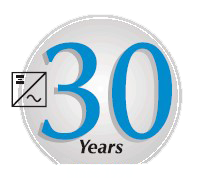Sine wave inverters convert Direct Current (DC) to sinusoidal Alternating Current (AC). Unlike non-sinusoidal current, which has an angular waveform, sinusoidal current has an undulating waveform that represents the “purity” of the current in terms of its oscillation between positive and negative voltages. Whereas non-sinusoidal current commonly produces signs of harmonic distortion, sinusoidal current — which is the type of currently utility lines supply — does not.
In addition to sine wave inverters, square wave inverters and modified sine wave inverters also convert DC to AC. However, in terms of harmonic distortion and quality of the equipment’s operation, the effect these inverters have on electrical equipment varies considerably. If your company needs inverters, and you would like more information about sine wave inverters before you make a purchase, the questions below should be helpful.
What is the difference between the three types of waves?
AC has a varying voltage that oscillates between positive and negative. A sine wave oscillates without pausing. A modified sine wave reaches a plateau of positive voltage, briefly drops to zero voltage, briefly drops to negative voltage, briefly raises to zero voltage, then reaches a plateau of positive voltage again. A square wave reaches a plateau of positive voltage, briefly drops to a negative voltage, then reaches a plateau of positive voltage again.
Which type of inverter costs the least?
Square inverters, which are the cheapest to produce, cost the least, followed by modified sine wave inverters, followed by sine wave inverters. Although the latter typically cost the most, they are essential to use with equipment that requires a sinusoidal wave to operate efficiently.
What type of equipment requires a sine wave inverter?
In general, complex electronic equipment such as high-end speakers, computers, televisions, and medical equipment requires a sinusoidal current to operate correctly. If in doubt about whether a piece of equipment requires sinusoidal current, contact to the manufacturer.
In addition to current, what other factors influence the choice of an inverter?
In addition to the type of current they produce, inverters are also chosen based on their size (e.g., the “power surge” rating and the “usual power” rating) and whether they are suitable for the operating environment. In terms of being suitable for their environment, inverters are commonly chosen based on NEBS certification.
What is NEBS certification?
Bell Labs developed Network Equipment-Building System (NEBS) standards in the 1970s. The standards are used to certify that electrical equipment is designed to operate under certain conditions. There are three levels of certification: level 1, which applies to equipment that meets the personnel and equipment safety requirements of GR-63-CORE and GR-1089-CORE; level two, which applies to equipment that meets the operating requirements of a certain environment (e.g. a data center), and level three, which meets all the requirements of GR-63-CORE and GR-1089-CORE.
Contact Exeltech Today
If you have questions about sine wave inverters or electricity conduction issues, contact the specialists at Exeltech. We have years of experience helping companies choose the right inverters for their needs. For more information about our products or services, call us today at (800) 886-4683, or click here to use our contact form.




